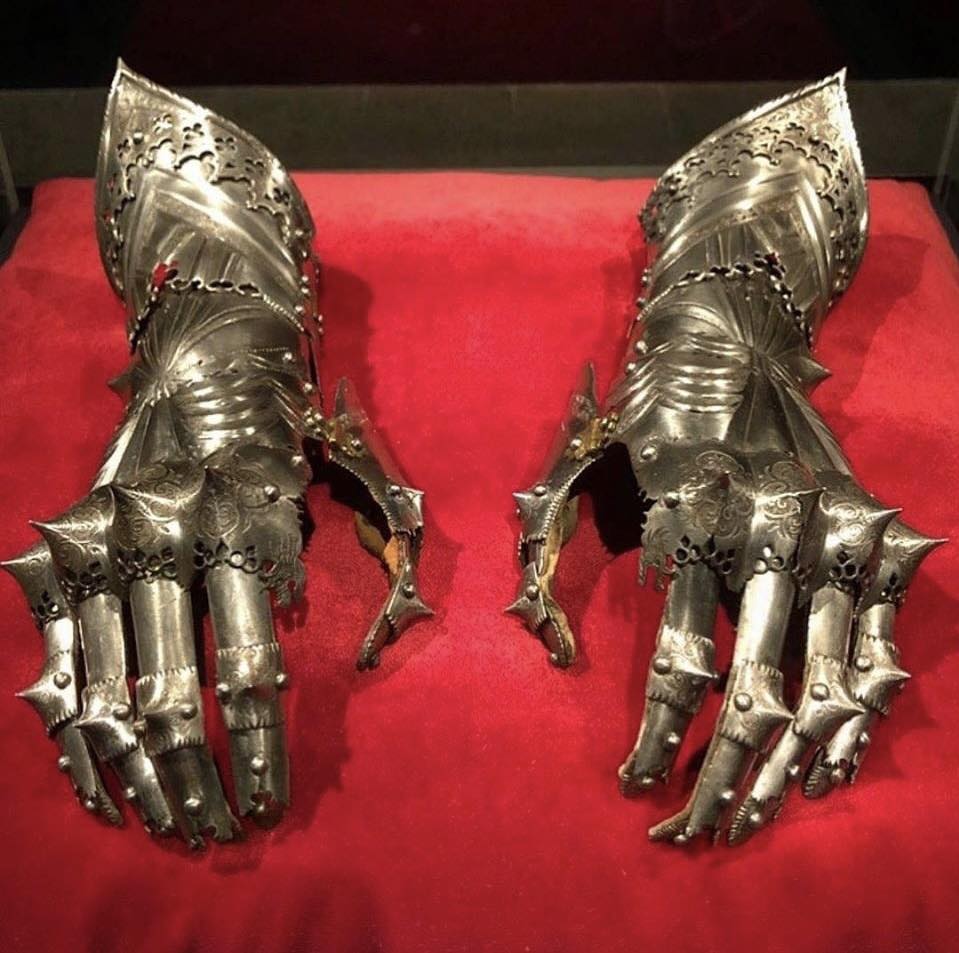The armored gauntlets once owned by the Holy Roman Emperor Maximilian I stand as a striking testament to the artistry and craftsmanship of medieval European armorers. These gauntlets, worn by Maximilian from 1508 until his death in 1519, represent more than just protective gear—they symbolize the power, prestige, and martial prowess of one of the most influential rulers of the late Middle Ages and early Renaissance. Their intricate design, masterful construction, and historical significance offer a unique insight into both the technological advancements of the period and the personality of the emperor himself.

Maximilian I, a member of the House of Habsburg, ascended to the throne of the Holy Roman Empire in 1508. Known for his military campaigns, strategic marriages, and deep interest in chivalric tradition, Maximilian played a crucial role in shaping the political landscape of Europe. His reign was characterized by efforts to modernize the empire’s military, as well as an emphasis on the importance of knightly virtues. These values were not merely theoretical but were embodied in the armor he commissioned and wore.
The gauntlets in question are an exceptional example of the period’s elite armoring techniques. Crafted by highly skilled artisans, they exhibit a combination of form and function that was characteristic of early 16th-century European armor. Unlike the bulkier designs of earlier centuries, these gauntlets were tailored to provide maximum mobility while maintaining high levels of protection. They were likely forged in the workshops of some of the most renowned armorers of the time, possibly from the regions of Nuremberg or Innsbruck, both of which were famous for producing superior military equipment.
The craftsmanship of Maximilian’s gauntlets is particularly notable for the detailed fluting—a series of ridges and grooves meticulously incorporated into the metal. This feature was not only aesthetically pleasing but also served a practical function, reinforcing the structural integrity of the metal while allowing for a lighter overall weight. The fluted style, often referred to as “Maximilian armor,” became highly popular during his reign and influenced European armor design for decades.
Beyond their practical utility, these gauntlets were also a symbol of imperial authority. Armor was more than just battlefield equipment; it was a statement of rank and status. The Holy Roman Emperor’s armor had to be both functional and visually impressive, reflecting his divine right to rule. The design of Maximilian’s gauntlets included fine etchings and embellishments, likely featuring motifs of the empire’s heraldry, religious symbols, or personal insignias that reinforced his legitimacy as a ruler.
While Maximilian was a formidable military leader, he was also a man deeply invested in the ideals of knighthood and the romanticized vision of chivalry. He sought to revive the grandeur of medieval tournaments and often participated in jousting events. His gauntlets, therefore, were not just battlefield tools but also pieces of ceremonial regalia used in such tournaments. These events, which combined military training with public spectacle, allowed him to project his strength and reinforce his image as a warrior-king.
The period in which Maximilian reigned was one of transition. The late 15th and early 16th centuries saw the rise of firearms, which gradually rendered traditional plate armor less effective on the battlefield. However, even as military tactics evolved, Maximilian remained dedicated to the refinement of plate armor, pushing armorers to innovate and produce increasingly sophisticated designs. His personal armor, including these gauntlets, reflected a delicate balance between tradition and adaptation to new warfare realities.
The survival of these gauntlets to the present day is remarkable, given the tumultuous history of European warfare and the eventual obsolescence of full plate armor. Many pieces of armor from this period were melted down or lost over time, but those belonging to figures of historical significance were often preserved in royal collections or museums. The gauntlets of Maximilian I are now treasured artifacts, offering scholars and enthusiasts alike a glimpse into the past.
Studying these gauntlets provides insight into the emperor’s personality. Maximilian was known not only as a warrior and statesman but also as a patron of the arts and an intellectual who valued innovation. His armor was a reflection of his multifaceted character—blending strength, elegance, and advanced engineering. Even today, his legacy endures through these tangible remnants of his rule.
The study of historical armor extends beyond its military function; it allows us to explore the broader cultural and social dimensions of the time. The gauntlets of Maximilian I were not simply defensive tools but symbols of an era where personal combat, pageantry, and political power were deeply interconnected. In wearing them, Maximilian was not just preparing for war—he was reinforcing the image of the ideal Renaissance ruler, one who could wield both the sword and the pen with equal skill.
In modern times, these gauntlets serve as an educational and cultural bridge, linking us to a past where craftsmanship, martial skill, and political strategy were intricately woven together. Museums and historians continue to study and preserve such artifacts, ensuring that the stories they hold remain accessible to future generations. For anyone fascinated by medieval history, chivalry, or the art of armor-making, the gauntlets of Maximilian I represent a remarkable chapter in the evolution of European arms and armor.
Maximilian’s reign may have ended over five centuries ago, but his influence endures. His efforts in military strategy, statecraft, and cultural patronage left an indelible mark on European history. His armored gauntlets, once worn in battle and in grand tournaments, now stand as a testament to his legacy—one that continues to captivate historians, collectors, and history enthusiasts worldwide.
Through their impeccable craftsmanship, these gauntlets tell a story of resilience, innovation, and the ever-evolving nature of warfare and power. As one of the most significant pieces of armor from the early 16th century, they remain a powerful link to an emperor whose vision shaped the course of European history.





